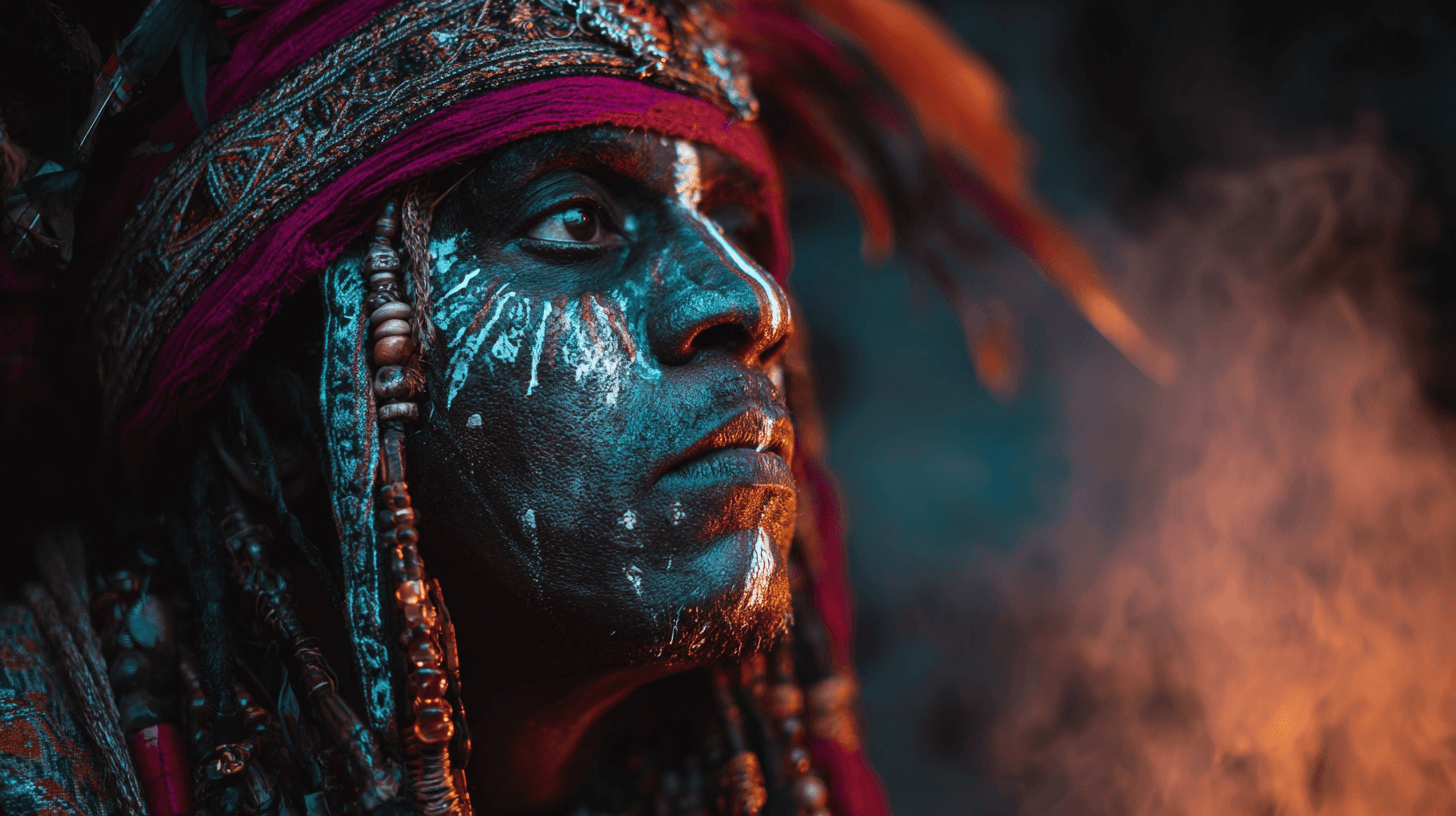The loa are central figures in Voodoo’s spiritual hierarchy. They act as intermediaries between humans and the distant creator, each with distinct personalities, domains, and ritual preferences.
This structure frames the religion as monotheistic in thought, with a remote creator and active intermediaries who shape daily life. Ceremonies open through figures like Legba, and offerings, veves, drumming, and dance mark a coded system of practice.
Contrary to sensational portrayals as mere “gods” or “demons,” these beings function as relational partners. Possession is a sacred conduit for communication and healing, not spectacle.
The tradition blends African, Caribbean, and Indigenous roots, adapting across the world from Haiti to New Orleans while preserving core rites. Key families and figures—Damballa, Erzulie, Ogou, Baron Samedi—will be examined in depth later.
Key Takeaways
- The loa serve as active mediators between people and a distant creator.
- Rituals use offerings, veves, drumming, dance, and possession for contact and care.
- Practices are community-centered and rooted in long history and traditions.
- Syncretism with Catholic forms preserved identity under colonial rule.
- New Orleans and Haiti show regional adaptation while keeping core beliefs.
Origins And Structure Of The Vodou Pantheon
The pantheon grew from a single distant creator and a crowded field of intermediaries who guided daily life. Followers affirmed one supreme being, Bondye, who remained beyond direct contact. Ritual life therefore focused on intermediary figures who could act in the human world.
Bondye And The Role Of Intermediary Spirits
Bondye stands apart as the remote creator. Communities petitioned intermediary spirits to address health, labor, and family needs. Possession, offerings, and veves offered practical channels for communication.
Syncretism With Catholic Saints And Folk Traditions
Enslaved people from West Africa brought their roots and beliefs to Saint-Domingue. They adapted practices by aligning many intermediaries with Catholic saints. This strategic syncretism let ritual use of candles, bells, and saint images preserve core cosmology under colonial rule.
- Monotheistic Framework: One creator with many active mediators.
- Cultural Blend: West African roots mixed with Catholic objects and local traditions.
- Wide Pantheon: Families of intermediaries numbered in poetic totals, signaling vastness rather than a fixed list.
Voodoo Spirits Loa Deities Haitian Louisiana Vodou
A shared African heritage produced varied regional systems, each tuned to local history and needs. Communities carried rituals, songs, and symbols across the Atlantic and reshaped them in new social settings.
Haitian Vodou grew from West African beliefs blended with Catholic practice. In New Orleans, Native and European folklore added local color. Both kept core actions: veves, offerings, drumming, dance, and possession.
Shared Roots And Regional Expressions
Major figures—including Legba, Damballa, Erzulie, Ogou, and Baron Samedi—appear across regions with local variations. Leaders like Marie Laveau helped formalize practice in New Orleans and left lasting community roles.
“Rituals served daily life: healing, memory, protection, and rites of passage.”
- Practices remained community-centered and adaptive.
- Death rites and memorials balanced care and continuity.
- Love and beauty were embodied in Erzulie while Ogou represented power.
| Feature | Haitian Context | New Orleans Context | Shared Elements |
|---|---|---|---|
| Origins | West Africa + Catholic syncretism | West Africa + Native/European influences | Common West African roots |
| Rituals | Veves, offerings, possession | Drumming, procession, spirit communication | Dance, music, offerings |
| Leadership | Houngans, Mambos | Priests, priestesses (e.g., Marie Laveau) | Community-based clergy |
| Social Role | Holistic care across life and death | Community guidance and healing | Everyday religious practice |
For a concise primer on intermediary figures, see this overview. To compare regional differences in depth, consult a comparative guide.
Papa Legba: Guardian Of Crossroads And Gateways
At the heart of many ceremonies stood a single figure whose presence opened pathways between people and the sacred. Papa Legba acted as the gatekeeper between the mortal world and the unseen realm. He was pictured as an older man with a cane, often accompanied by dogs, and known by names such as Atibon Legba, Legba Met Kafou, and Legba Potay.
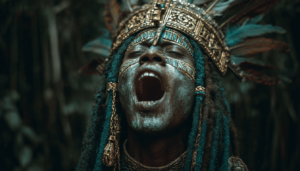
First To Be Invoked In Ceremony
He was always the first to be invoked so other entities could enter the space. Followers addressed him at the start to secure safe passage and orderly contact.
His presence guided divination and counsel, helping people weigh major life choices. Without the opener, no proper ceremony proceeded.
Veve, Offerings, And Saint Peter Association
Legba’s veve marked the ritual area and signaled that the gateway stood ready. Offerings favored flame-grilled foods and small tokens that matched his tastes.
He was often associated with Saint Peter, a syncretic link that emphasized his gatekeeper function. That association helped communities preserve continuity of practice under external pressures.
| Aspect | Description | Ritual Signal |
|---|---|---|
| Role | Opener of the way; mediator at crossroads | Invocation at start |
| Typical Image | Old man with cane; dogs nearby | Veve drawn |
| Offerings | Flame-grilled foods, simple tokens | Placed at gateway |
Damballa And Ayida Wedo: Creation, Wisdom, And The Rainbow
The paired serpents of Damballa and Ayida Wedo frame creation as a living balance between sky and soil. Their union forms a central image for ritual meaning and everyday practice.
Damballa is revered as a primordial force, often depicted as a vast white serpent. He symbolizes creation, calm wisdom, and the earth’s contours. Followers traditionally offer white foods, especially eggs, on altars to honor his purity.
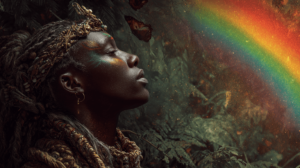
Intertwined Serpents And Symbols Of Balance
Ayida Wedo appears as the rainbow, bringing rain, beauty, and harmony to the land. Together the two represent sky and soil in complementary motion.
The intertwined motif is visible on drums, furniture, and the poto mitan. These images orient participants to cosmological order during rites and signal creative power to those present.
| Aspect | Meaning | Ritual Signal |
|---|---|---|
| Iconography | Entwined serpents | Drum motifs, central pole |
| Offerings | White foods (eggs), simple tokens | Clean, white-clothed altar |
| Functions | Creation, rain, renewal | Seasonal prayers, water rites |
Syncretic links tie Damballa to Saint Patrick, reflecting layered history and survival under changing conditions. Their combined presence balances realms above and below and complements other forces that govern love, war, or death.
Erzulie In Her Many Forms: Freda, Dantor, And Feminine Power
Erzulie (also known as Ezili) names a family of water-associated figures who embody different facets of feminine power. They range from courtly charm to fierce maternal defense.
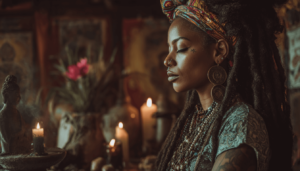
Erzulie Freda: Love, Beauty, And Coquetry
Erzulie Freda presides over love and refined elegance. She loves perfume, jewels, and fine dress and often grants gifts and romantic favor.
Petitioners approach with etiquette: offerings favor sweet scents and delicate foods. Her blessings can be generous yet capricious, so practitioners learn careful manners and patience.
Ezili Dantor: Warrior Mother And Patron Of Haiti
Ezili Dantor appears as a scarred, protective mother. She defends children, orphans, and the abused and holds deep ties to revolutionary memory.
Her image is austere, often depicted with facial scars and a sword or knife. Communities turn to her for strength and communal resilience.
“Erzulie’s family holds both tenderness and ferocity, serving households and broader social struggle alike.”
- Inclusive possession: Erzulie commonly chooses women and feminine men (masisi).
- Different symbols and colors mark Freda’s courtship versus Dantor’s stern defense.
- Practitioners balance petitions—romance from Freda, resilience from Dantor.
| Aspect | Erzulie Freda | Ezili Dantor |
|---|---|---|
| Domain | Love, beauty, courtship | Protection, justice, motherhood |
| Iconography | Perfume, jewels, pink/white colors | Facial scars, dark tones, weapon |
| Offerings | Sweets, flowers, fine cloth | Strong foods, rum, protective tokens |
| Social Role | Romance, personal charm | Community defense, revolutionary memory |
For a concise Erzulie overview, see Erzulie overview. A focused Ezili Dantor profile explores her role as protector.
Ogou: Warrior Spirit Of Fire, Forge, And Discipline
Ogou appears as a composite warrior who fuses iron, heat, and resolve into a single guiding presence.
He manifests in many forms—Ogou Feray, Ogou Batala, and Ogou Badagri—each tied to the sword, the forge, or raw ferocity.
His lineage traces back to the martial roots of the Oyo Empire, giving his role clear historical weight.
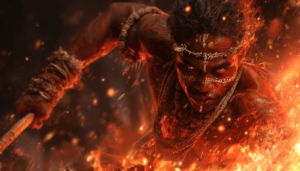
In ritual, his veve reads as royal. It signals sovereignty and protective stewardship for the community.
Offerings and songs for Ogou emphasize control and strength. They call in power without inviting chaos.
- He trains devotees for courage, boundaries, and endurance.
- Sword and forge imagery show transformation under pressure.
- Different aspects bring tactical nuance—ferocity, guardianship, or law.
“Petitioners turn to Ogou before critical challenges, aligning will with disciplined action.”
| Aspect | Meaning | Ritual Signal |
|---|---|---|
| Forms | Feray (ferocity), Batala (law), Badagri (guardianship) | Distinct drums, colors, offerings |
| Roots | Oyo Empire martial tradition | Royal veve; iron tokens |
| Function | Discipline, leadership, community defense | Songs and structured practices |
Ogou stands as a counterbalance to softer domains such as love and beauty. His presence readies communities and individuals for decisive, ethical action.
Baron Samedi And The Gede: Death, Healing, And The Afterlife
Baron Samedi and the Gede presided over the thin line between life and death. They guarded graves, kept memory alive, and answered hard petitions for healing and justice. Their presence reminded communities that death remained a relationship to be cared for, not a final cutoff.
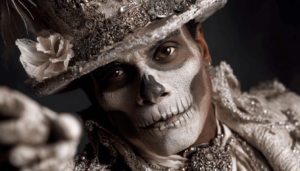
Iconography: Top Hat, Dark Glasses, And Skull Face
The leader was often depicted in a black suit, a tall hat, and dark glasses, his face painted like a skull. This hat and mask served as ritual signals of mortality and irreverent humor. By shocking witnesses he taught truth and exposed hidden harms.
Gede Family: Maman Brigitte, Baron Lacroix, And Gede Nibo
The Gede included Maman Brigitte, Baron Lacroix, Baron Kriminel, Gede Nibo, and Papa Gede. Maman Brigitte mixed Irish associations with fierce healing. She favored dark rum with hot peppers and protected women and graves.
Possession in ceremony took a raucous, comic form. The Gede used blunt speech and jokes to reveal secrets and to heal. Followers petitioned them for protection, to lift curses, and to return the dying to life.
| Aspect | Meaning | Ritual Signal |
|---|---|---|
| Head | Baron Samedi – guardian of thresholds | Top hat, skull face, dark glasses |
| Healer | Maman Brigitte – protector, medical rites | Dark rum, hot peppers, graveside offerings |
| Family Role | Baron Lacroix, Gede Nibo – justice, memory | Grave rituals, blunt truth-telling |
“Death in this tradition is a continuation of ties; the Gede tend those ties and restore life where possible.”
Agwe And La Sirène: Masters Of The Sea And Its Bounty
Ocean-facing altars focused attention on currents, navigation, and the fragile link between harvest and hazard. Coastal communities relied on these ocean-centered figures to protect boats, nets, and lives at sea.
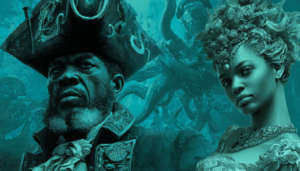
Navigating Offerings, Possession, And Ocean Rituals
Agwe governed the sea’s riches from his mythic home, Nan Zile. Fishermen, sailors, and shore households built altars that looked seaward and played songs that echoed waves.
La Sirène appeared as a mermaid queen of wealth and caprice, with another form, Labalenn, manifesting the whale’s deep strength. Offerings—shells, rum, maritime tokens—matched the marine nature she oversaw.
Possession by Agwe often turned the body toward the ocean, a clear signal of his presence. In ceremony, music and gestures imitated navigation so the spirit could speak guidance or warning.
- Practitioners staged rites on boats, beaches, or river mouths to align with currents and tides.
- Petitioners approached these courts with humility, mindful of bounty and risk.
- La Sirène’s allure promised prosperity but could shift suddenly, so rituals balanced gift and caution.
Service to the sea tied seasonal harvests and livelihoods to a wider world ecology. These oceanic figures remained central to local life, guiding work, safety, and the rhythms of coastal communities within the broader voodoo practice.
Kouzen Zaka: Farmer Loa Of Labor, Harvest, And Prosperity
Kouzen Zaka embodies the dignity of work and the rhythms of planting and harvest. He is beloved in rural communities and appears with a straw hat, a machete, and a djakout. These items are practical symbols that tie sacred care to daily labor.
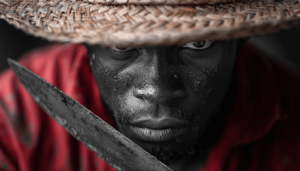
His feast day falls on May 1, a time when fields, tools, and people receive blessing. Offerings are plain and earned: produce, tools, simple foods, and songs that honor honest effort.
He rewards diligence and discourages idleness. Stories show Kouzen Zaka “consuming” sloth while protecting crops, clear weather, and fair markets. Farmers seek him for harvest safety and steady trade.
| Aspect | Meaning | Ritual Signal |
|---|---|---|
| Iconography | Straw hat, machete, djakout | Field altars, simple tools |
| Feast Day | May 1 – labor and harvest | Field blessings, shared meals |
| Syncretism | Linked with Saint Isidore | Church feast paired with rural rites |
Lineages sometimes show him as Ti-Zaka, a childlike figure, stressing both youth and maturity in the same household tradition. For a focused profile, see the Kouzen Zaka profile. In sum, he makes subsistence, community resilience, and honest work a sacred part of life and local practice.
Priesthood, Rituals, And Possession In Haitian And Louisiana Vodou
Priests and priestesses organized public life by timing drums, drawings, and feasts to answer urgent needs. Ceremonies centered on intermediary figures, not the distant creator, and focused on healing, guidance, and social order.
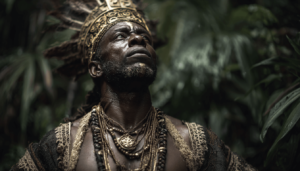
Drumming, Dance, And Veves As Spirit Beacons
Drumming and dance created clear rhythmic cues that signaled invitation and guided safe possession. Skilled drummers changed tempo to indicate which spirit might approach.
Veves—precise ritual drawings—served as beacons on the floor. Each design marked a specific court and helped practitioners focus the ceremony.
Offerings, Spirit “Feeding,” And Community Ceremony
Offerings functioned as feeding: foods and drinks matched a spirit’s tastes. For example, Legba favored grilled foods, Maman Brigitte took dark rum with peppers, and Damballa received white foods.
Communities staged rites for illness, dispute resolution, birth, and death. These ceremonies folded spiritual care into regular neighborhood life rather than separating ritual from daily concerns.
Houngans, Mambos, And The Legacy Of Marie Laveau
Houngans and mambos trained new generations, preserving songs, language, and ritual sequences. They taught safe procedures for possession and public ceremony.
In New Orleans, leadership figures like Marie Laveau fused civic and spiritual roles. Her legacy shows how temple life, shops, and procession shaped city culture and public care.
“Rituals served daily life: healing, memory, protection, and rites of passage.”
| Role | Function | Ritual Signal |
|---|---|---|
| Drummers & Dancers | Invite and guide possession | Tempo change; call-and-response |
| Priests/Priestesses | Teach, mediate, heal | Veves, offerings, prayers |
| Community | Support social rites | Feasts, processions, consultations |
For a concise historical overview of practice and adaptation, see this primer. To explore regional ritual differences, consult a comparative guide.
Conclusion
At its core is a network of active figures who bring care and counsel into ordinary life. This pantheon worked within a monotheistic frame: a distant creator and many intermediaries who guide work, healing, and justice.
Across history, diaspora peoples preserved meaning through syncretism and local change. Offerings, veves, drumming, and possession made sacred presence tangible and practical for communities.
The system balanced life and death—figures such as Baron Samedi and the Gede framed transition as relationship and renewal. Leaders like Marie Laveau translated devotion into public service.
Readers are invited to approach these practices on their own terms and with respect. For a focused primer on the Loa and their roles, see Loa and Their Roles.
